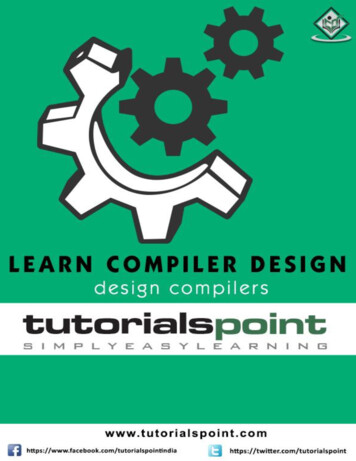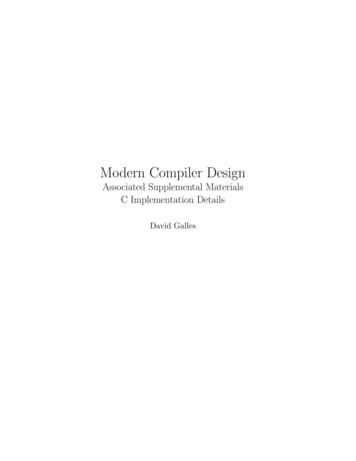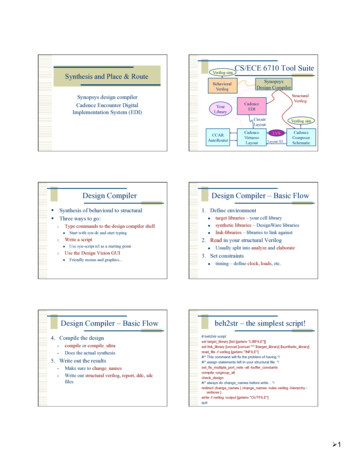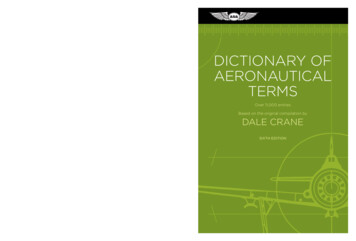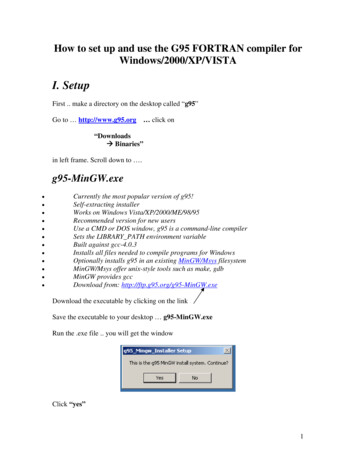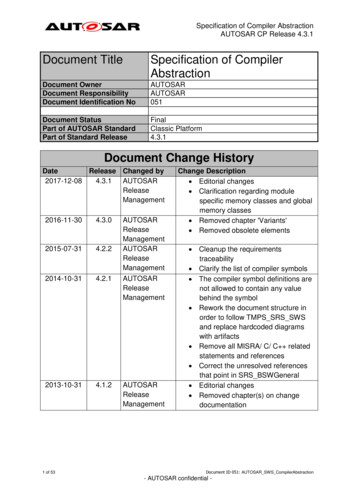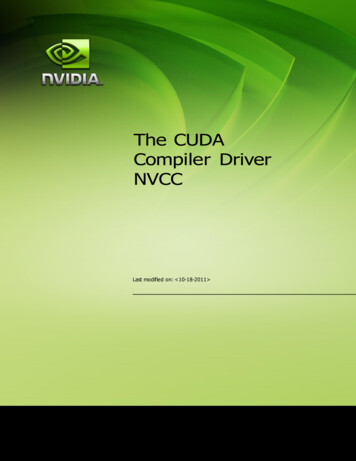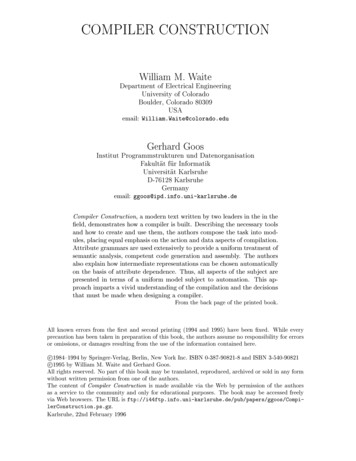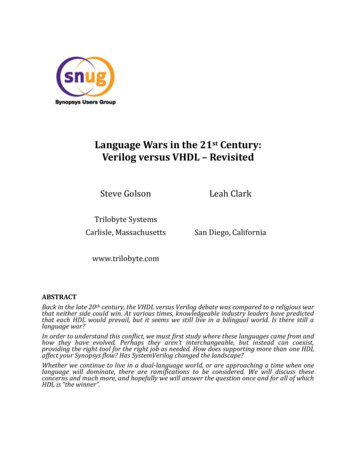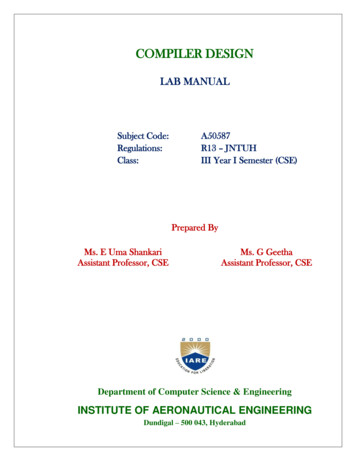
Transcription
COMPILER DESIGNLAB MANUALSubject Code:Regulations:Class:A50587R13 – JNTUHIII Year I Semester (CSE)Prepared ByMs. E Uma ShankariAssistant Professor, CSEMs. G GeethaAssistant Professor, CSEDepartment of Computer Science & EngineeringINSTITUTE OF AERONAUTICAL ENGINEERINGDundigal – 500 043, Hyderabad
INSTITUTE OF AERONAUTICAL ENGINEERINGDundigal, Hyderabad - 500 043COMPUTER SCIENCE AND ENGINEERINGProgram ineering knowledge: Apply the knowledge of mathematics, science, engineering fundamentals,and an engineering specialization to the solution of complex engineering problems.Problem analysis: Identify, formulate, review research literature, and analyze complex engineeringproblems reaching substantiated conclusions using first principles of mathematics, natural sciences,and engineering sciences.Design/development of solutions: Design solutions for complex engineering problems and designsystem components or processes that meet the specified needs with appropriate consideration forthe public health and safety, and the cultural, societal, and environmental considerations.Conduct investigations of complex problems: Use research-based knowledge and research methodsincluding design of experiments, analysis and interpretation of data, and synthesis of the informationto provide valid conclusions.Modern tool usage: Create, select, and apply appropriate techniques, resources, and modernengineering and IT tools including prediction and modeling to complex engineering activities with anunderstanding of the limitations.The engineer and society: Apply reasoning informed by the contextual knowledge to assess societal,health, safety, legal and cultural issues and the consequent responsibilities relevant to theprofessional engineering practice.Environment and sustainability: Understand the impact of the professional engineering solutions insocietal and environmental contexts, and demonstrate the knowledge of, and need for sustainabledevelopment.Ethics: Apply ethical principles and commit to professional ethics and responsibilities and norms ofthe engineering practice.Individual and team work: Function effectively as an individual, and as a member or leader in diverseteams, and in multidisciplinary settings.Communication: Communicate effectively on complex engineering activities with the engineeringcommunity and with society at large, such as, being able to comprehend and write effective reportsand design documentation, make effective presentations, and give and receive clear instructions.Project management and finance: Demonstrate knowledge and understanding of the engineeringand management principles and apply these to one’s own work, as a member and leader in a team, tomanage projects and in multidisciplinary environments.Life-long learning: Recognize the need for, and have the preparation and ability to engage inindependent and life-long learning in the broadest context of technological change.Program Specific OutcomesPSO1PSO2PSO3Professional Skills: The ability to research, understand and implement computer programs in theareas related to algorithms, system software, multimedia, web design, big data analytics, andnetworking for efficient analysis and design of computer-based systems of varying complexity.Problem-Solving Skills: The ability to apply standard practices and strategies in software projectdevelopment using open-ended programming environments to deliver a quality product for businesssuccess.Successful Career and Entrepreneurship: The ability to employ modern computer languages,environments, and platforms in creating innovative career paths, to be an entrepreneur, and a zestfor higher studies.
COMPILER DESIGN LAB SYLLABUSSl. No.1List of ExperimentsPage No.Design a lexical analyzer for given language and the lexical analyzer should ignoreredundant spaces, tabs and new lines. It should also ignore comments. Although thesyntax specification states that identifiers can be arbitrarily long, you may restrict thelength to some reasonable value. Simulate the same in C language.1* Write a C program to identify whether a given line is a comment or not.4*Write a C program to recognize strings under 'a', 'a*b ', 'abb'.5*Write a C program to test whether a given identifier is valid or not.8*Write a C program to simulate lexical analyzer for validating operators.96Implement the lexical analyzer using JLex, flex or other lexical analyzer generatingtools.117Write a C program for implementing the functionalities of predictive parser for the minilanguage specified in Note 1.138a) *Write a C program for constructing of LL (1) parsing.b) *Write a C program for constructing recursive descent parsing.17Write a C program to implement LALR parsing.2423459101112a) *Write a C program to implement operator precedence parsing.b) *Write a C program to implement Program semantic rules tocalculate theexpression that takes an expression with digits, and * and computes the value.Convert the BNF rules into Yacc form and write code to generate abstract syntax treefor the mini language specified in Note 1.Write a C program to generate machine code from abstract syntax tree generated by theparser. The instruction set specified in Note 2 may be considered as the target code.*Content beyond the University prescribed syllabi323944
Note 1:A simple language written in this language is{int a[3],t1,t2;T1 2;A[0] 1;a[1] 2;a[t] 3;T2 -( a[2] t1*6)/(a[2]-t1);If t2 5thenPrint(t2)Else{Int t3;T3 99;T2 25;Print(-t1 t2*t3);/*this is a comment on 2 lines*/}endif}Comments(zero or more characters enclosed between the standard C/JAVA Style comment brackets/* */)can beinserted .The language has rudimentary support for1-dimenstional array,the declaration int a[3] declares an array ofthree elements,referenced as a[0],a[1] and a[2].Note also you should worry about the scopping of names.Note 2:Consider the following mini language, a simple procedural high –level language, only operating on integer data, with asyntax looking vaguely like a simple C crossed with pascal. The syntax of the language is defined by the followinggrammar. program :: block block :: { variable definition slist } { slist } variabledefinition :: int vardeflist vardec :: identifier identifier [ constant ] slist :: statement statement ; slist statement :: assignment ifstament whilestatement block printstament empty assignment :: identifier expression identifier [ expression ] expression if statement :: if bexpression then slist else slist endif if bexpression then slisi endif whilestatement :: while bexpreession do slisi enddo printstatement :; print( expression ) expression :: expression :: expression addingop term term addingop term bexprssion :: expression relop expression relop :: ! addingop :: term :: term multop factor factor Multop :: * / factor :: constant identifier identifier [ expression ] ( expression ) constant :: digit digit constant
identifier :: identifier letter or digit letter letter or digit :: letter digit letter :; a b c d e f g h I j k l m n o p q r s t u v w x y z digit :: 0 1 2 3 4 5 7 8 9 empty :: has the obvious meaning
ATTAINMENT OF PROGRAM OUTCOMES& PROGRAM SPECIFIC OUTCOMESExp.No.1234ExperimentDesign a lexical analyzer for given language and the lexical analyzershould ignore redundant spaces, tabs and new lines. It should alsoignore comments. Although the syntax specification states thatidentifiers can be arbitrarily long, you may restrict the length to somereasonable value. Simulate the same in C language.* Write a C program to identify whether a given line is a comment ornot.*Write a C program to recognize strings under 'a', 'a*b ', 'abb'.*Write a C program to test whether a given identifier is valid or not.ProgramOutcomesAttainedPO1, PO2, PO3ProgramSpecificOutcomesAttainedPSO1PO1PSO1PO1, PO2PSO1, PSO2PO1PSO15*Write a C program to simulate lexical analyzer for validatingoperators.PO1, PO2, PO3PSO1, PSO26Implement the lexical analyzer using JLex, flex or other lexicalanalyzer generating tools.PO1, PO2PSO17Write a C program for implementing the functionalities of predictiveparser for the mini language specified in Note 1.PO1, PO2, PO4,PO5PSO18a) *Write a C program for constructing of LL (1) parsing.b) *Write a C program for constructing recursive descent parsing.PO1, PO2, PO3,PO4PSO1, PSO2Write a C program to implement LALR parsing.PO1, PO2, PO4PSO1PO1, PO2PSO1, PSO2PO1, PO2PSO1PO1, PO2, PO3,PO4, PO5PSO19101112a) *Write a C program to implement operator precedence parsing.b) *Write a C program to implement Program semantic rules tocalculate the expression that takes an expression with digits, and * and computes the value.Convert the BNF rules into Yacc form and write code to generateabstract syntax tree for the mini language specified in Note 1.Write a C program to generate machine code from abstract syntax treegenerated by the parser. The instruction set specified in Note 2 may beconsidered as the target code.*Content beyond the University prescribed syllabi
COMPILER DESIGN LABORATORYOBJECTIVE:This laboratory course is intended to make the students experiment on the basic techniques of compilerconstruction and tools that can used to perform syntax-directed translation of a high-level programminglanguage into an executable code. Students will design and implement language processors in C by usingtools to automate parts of the implementation process. This will provide deeper insights into the moreadvanced semantics aspects of programming languages, code generation, machine independentoptimizations, dynamic memory allocation, and object orientation.OUTCOMES:Upon the completion of Compiler Design practical course, the student will be able to:1. Understand the working of lex and yacc compiler for debugging of programs.2. Understand and define the role of lexical analyzer, use of regular expression and transitiondiagrams.3. Understand and use Context free grammar, and parse tree construction.4. Learn & use the new tools and technologies used for designing a compiler.5. Develop program for solving parser problems.6. Learn how to write programs that execute faster.
EXPERIMENT- 11.1OBJECTIVE:Design a lexical analyzer for given language and the lexical analyzer should ignore redundant spaces, tabs andnew lines. It should also ignore comments. Although the syntax specification states that identifiers can bearbitrarily long, you may restrict the length to some reasonable value. Simulate the same in C language.1.2RESOURCE:Turbo C 1.3PROGRAM LOGIC:1. Read the input Expression2. Check whether input is alphabet or digits then store it as identifier3. If the input is is operator store it as symbol4. Check the input for keywords1.4PROCEDURE:Go to debug - run or press CTRL F9 to run the program1.5PROGRAM:#include string.h #include ctype.h #include stdio.h void keyword(char str[10]){if(strcmp("for",str) 0 strcmp("while",str) 0 strcmp("do",str) 0 strcmp("int",str) 0 strcmp("float",str) 0 strcmp("char",str) 0 strcmp("double",str) 0 strcmp("static",str) 0 strcmp("switch",str) 0 strcmp("case",str) 0)printf("\n%s is a keyword",str);elseprintf("\n%s is an identifier",str);}main(){FILE *f1,*f2,*f3;char c,str[10],st1[10];int num[100],lineno 0,tokenvalue 0,i 0,j 0,k 0;printf("\nEnter the c program");/*gets(st1);*/f1 fopen("input","w");while((c getchar())! EOF)putc(c,f1);fclose(f1);f1 fopen("input","r");f2 fopen("identifier","w");f3 fopen("specialchar","w");while((c getc(f1))! EOF) {if(isdigit(c)){tokenvalue c-'0';1
c getc(f1);while(isdigit(c))tokenvalue* 10 c-'0';c getc(f1);}num[i ] c,f2);c getc(f1);while(isdigit(c) isalpha(c) c ' ' c ' '){putc(c,f2);c getc(f1);}putc(' ',f2);ungetc(c,f1);}elseif(c ' ' c '\t')printf(" ");elseif(c '\n')lineno printf("\nThe no's in the program are");for(j 0;j i;j )printf("%d",num[j]);printf("\n");f2 fopen("identifier","r");k 0;printf("The keywords and identifiersare:");while((c getc(f2))! EOF){if(c! ' ')str[k ] c;else{str[k] '\0';keyword(str);k 0;}2
}fclose(f2);f3 fopen("specialchar","r");printf("\nSpecial characters are");while((c getc(f3))! "Total no. of lines are:%d",lineno);}1.6PRE LAB QUESTIONS1. What is token?2. What is lexeme?3. What is the difference between token and lexeme?4. Define phase and pass?5. What is the difference between phase and pass?6. What is the difference between compiler and interpreter?1.7LAB ASSIGNMENT1. Write a program to recognize identifiers.2. Write a program to recognize constants.3. Write a program to recognize keywords and identifiers.4. Write a program to ignore the comments in the given input source program.1.8POST LAB QUESTIONS1. What is lexical analyzer?2. Which compiler is used for lexical analyzer?3. What is the output of Lexical analyzer?4. What is LEX source Program?1.9INPUT & OUTPUT:Input:Enter Program for termination:{int a[3],t1,t2;t1 2; a[0] 1; a[1] 2; a[t1] 3;t2 -(a[2] t1*6)/(a[2]-t1);if t2 5 thenprint(t2);else {int t3;t3 99;t2 -25;print(-t1 t2*t3); /* this is a comment on 2 lines */} endif} Output:Variables : a[3] t1 t2 t3Operator : - * / Constants : 2 1 3 6 5 99 -25Keywords : int if then else endifSpecial Symbols : , ; ( ) { }Comments : this is a comment on 2 lines3
EXPERIMENT-22.1OBJECTIVE:* Write a C program to identify whether a given line is a comment or not.2.2RESOURCE:Turbo C 2.3PROGRAM LOGIC:Read the input string.Check whether the string is starting with ‘/’ and check next character is ‘/’ or’*’.If condition satisfies print comment.Else not a comment.2.4PROCEDURE:Go to debug - run or press CTRL F9 to run the program.2.52.6PROGRAM:#include stdio.h #include conio.h void main(){char com[30];int i 2,a 0;clrscr();printf("\n Enter comment:");gets(com);if(com[0] '/') {if(com[1] '/')printf("\n It is a comment");else if(com[1] '*') {for(i 2;i 30;i ){if(com[i] '*'&&com[i 1] '/'){printf("\n It is a comment");a 1;break; }elsecontinue; }if(a 0)printf("\n It is not a comment");}elseprintf("\n It is not a comment");}elseprintf("\n It is not a comment");getch(); }INPUT & OUTPUT:Input: Enter comment: //helloOutput: It is a commentInput: Enter comment: helloOutput: It is not a comment4
EXPERIMENT-33.1OBJECTIVE:*Write a C program to recognize strings under 'a*', 'a*b ', 'abb'.3.2RESOURCE:Turbo C 3.3PROGRAM LOGIC:By using transition diagram we verify input of the state.If the state recognize the given pattern rule.Then print string is accepted under a*/ a*b / abb.Else print string not accepted.3.4PROCEDURE:Go to debug - run or press CTRL F9 to run the program.3.5PROGRAM:#include stdio.h #include conio.h #include string.h #include stdlib.h void main(){char s[20],c;int state 0,i 0;clrscr();printf("\n Enter a string:");gets(s);while(s[i]! '\0'){switch(state){case 0: c s[i ];if(c 'a')state 1;else if(c 'b')state 2;elsestate 6;break;case 1: c s[i ];if(c 'a')state 3;5
else if(c 'b')state 4;elsestate 6;break;case 2: c s[i ];if(c 'a')state 6;else if(c 'b')state 2;elsestate 6;break;case 3: c s[i ];if(c 'a')state 3;else if(c 'b')state 2;elsestate 6;break;case 4: c s[i ];if(c 'a')state 6;else if(c 'b')state 5;elsestate 6;break;case 5: c s[i ];if(c 'a')state 6;else if(c 'b')state 2;elsestate 6;break;case 6: printf("\n %s is not recognised.",s);exit(0);}}6
If(state 1)printf("\n %s is accepted under rule 'a'",s);else if((state 2) (state 4))printf("\n %s is accepted under rule 'a*b '",s);else if(state 5)printf("\n %s is accepted under rule 'abb'",s);getch();}3.6INPUT & OUTPUT:Input :Enter a String: aaaabbbbbOutput:aaaabbbbb is accepted under rule 'a*b 'Enter a string: cdgscdgs is not recognized7
EXPERIMENT-44.1OBJECTIVE:*Write a C program to test whether a given identifier is valid or not4.2RESOURCE:Turbo C 4.3PROGRAM LOGIC:Read the given input string.Check the initial character of the string is numerical or any special character except ‘ ’ then print it is not a valididentifier.Otherwise print it as valid identifier if remaining characters of string doesn’t contains any special charactersexcept ‘ ’.4.4PROCEDURE:Go to debug - run or press CTRL F9 to run the program.4.5PROGRAM:#include stdio.h #include conio.h #include ctype.h void main(){char a[10];int flag, i 1;clrscr();printf("\n Enter an identifier:");gets(a);if(isalpha(a[0]))flag 1;elseprintf("\n Not a valid identifier");while(a[i]! '\0'){if(!isdigit(a[i])&&!isalpha(a[i])){flag 0;break;}i ;}if(flag 1)printf("\n Valid identifier");getch();}4.6INPUT & OUTPUT:Input: Enter an identifier: firstOutput:Valid identifierEnter an identifier:1aqwNot a valid identifier8
EXPERIMENT-55.1OBJECTIVE:*Write a C program to simulate lexical analyzer for validating operators.5.2RESOURCE:Turbo C 5.3PROGRAM LOGIC :Read the given input.If the given input matches with any operator symbol.Then display in terms of words of the particular symbol.Else print not a operator.5.4PROCEDURE:Go to debug - run or press CTRL F9 to run the program.5.5PROGRAM:#include stdio.h #include conio.h void main(){char s[5];clrscr();printf("\n Enter any operator:");gets(s);switch(s[0]){case' ': if(s[1] ' ')printf("\n Greater than or equal");elseprintf("\n Greater than");break;case' ': if(s[1] ' ')printf("\n Less than or equal");elseprintf("\nLess than");break;case' ': if(s[1] ' ')printf("\nEqual to");elseprintf("\nAssignment");break;case'!': if(s[1] ' ')printf("\nNot Equal");elseprintf("\n Bit Not");break;case'&': if(s[1] '&')printf("\nLogical AND");elseprintf("\n Bitwise AND");break;case' ': if(s[1] ' ')printf("\nLogical OR");9
case' ;elseprintf("\nBitwise OR");break;printf("\n );break;printf("Modulus");break;printf("\n Not a operator");}5.6INPUT & OUTPUT:InputEnter any operator: *OutputMultiplication10
EXPERIMENT-66.1OBJECTIVE:Implement the lexical analyzer using JLex, flex or other lexical analyzer generating tools.6.2RESOURCE:Linux using Putty6.3PROGRAM LOGIC:Read the input string.Check whether the string is identifier/ keyword /symbol by using the rules of identifier and keywords usingLEX Tool6.4PROCEDURE:Go to terminal .Open vi editor ,Lex lex.l , cc lex.yy.c , ./a.out6.5PROGRAM:/* program name is lexp.l */%{/* program to recognize a c program */int COMMENT 0;%}identifier [a-zA-Z][a-zA-Z0-9]*%%#.* { printf("\n%s is a PREPROCESSOR DIRECTIVE",yytext);}int float char double while for do if break continue void switch case long struct const typedef return else goto {printf("\n\t%s is a KEYWORD",yytext);}"/*" {COMMENT 1;}/*{printf("\n\n\t%s is a COMMENT\n",yytext);}*/"*/" {COMMENT 0;}/* printf("\n\n\t%s is a COMMENT\n",yytext);}*/{identifier}\( { {if(!COMMENT) printf("\n BLOCK BEGINS");}} {if(!COMMENT) printf("\n BLOCK ENDS");}{identifier}(\[[0-9]*\])? {if(!COMMENT) printf("\n %s IDENTIFIER",yytext);}".*\" {if(!COMMENT) printf("\n\t%s is a STRING",yytext);}[0-9] {if(!COMMENT) printf("\n\t%s is a NUMBER",yytext);}{if(!COMMENT) printf("\n\t");ECHO;printf("\n");}( ECHO;{if(!COMMENT)printf("\n\t%s is an ASSIGNMENT OPERATOR",yytext);} {if(!COMMENT) printf("\n\t%s is a RELATIONAL OPERATOR",yytext);}%%int main(int argc,char **argv){if (argc 1){FILE *file;file fopen(argv[1],"r");if(!file){printf("could not open %s \n",argv[1]);exit(0);}yyin file;}yylex();11
6.6printf("\n\n");return 0;} int yywrap(){return 0;}PRE LAB QUESTIONS:1.2.3.4.5.6.7LAB ASSIGNMENT:1.2.3.6.8Write a program that defines auxiliary definitions and translation rules of Pascal tokens?Write a program that defines auxiliary definitions and translation rules of C tokens?Write a program that defines auxiliary definitions and translation rules of JAVA tokensPOST LAB QUESTIONS:1.2.3.4.5.6.6List the different sections available in LEX compiler?What is an auxiliary definition?How can we define the translation rules?What is regular expression?What is finite automaton?What is Jlex?What is Flex?What is lexical analyzer generator?What is the input for LEX Compiler?What is the output of LEX compiler?INPUT & OUTPUT:Input vi var.c#include stdio.h main(){int a,b;}Output lex lex.l cc lex.yy.c ./a.out var.c#include stdio.h is a PREPROCESSOR DIRECTIVEFUNCTIONmain ()BLOCK BEGINSint is a KEYWORDa IDENTIFIERb IDENTIFIERBLOCK ENDS12
EXPERIMENT-77.1OBJECTIVE:Write a C program for implementing the functionalities of predictive parser for the mini language specified inNote 1.7.2RESOURCE:Turbo C 7.3PROGRAM LOGIC:Read the input string.By using the FIRST AND FOLLOW values.Verify the FIRST of non terminal and insert the production in the FIRST valueIf we have any @ terms in FIRST then insert the productions in FOLLOW valuesConstructing the predictive parser table7.4PROCEDURE:Go to debug - run or press CTRL F9 to run the program.7.5PROGRAM:#include stdio.h #include conio.h #include string.h char prol[7][10] {"S","A","A","B","B","C","C"};char pror[7][10] {"A","Bb","Cd","aB","@","Cc","@"};char prod[7][10] {"S- A","A- Bb","A- Cd","B- aB","B- @","C- Cc","C- @"};char first[7][10] {"abcd","ab","cd","a@","@","c@","@"};char follow[7][10] {" "," "," ","a ","b ","c ","d "};char table[5][6][10];numr(char c){switch(c){case 'S': return 0;case 'A': return 1;case 'B': return 2;case 'C': return 3;case 'a': return 0;case 'b': return 1;case 'c': return 2;case 'd': return 3;case ' ': return 4;}13
return(2);}void main(){int i,j,k;clrscr();for(i 0;i 5;i )for(j 0;j 6;j )strcpy(table[i][j]," ");printf("\nThe following is the predictive parsing table for the following grammar:\n");for(i 0;i 7;i )printf("%s\n",prod[i]);printf("\nPredictive parsing table is\n");fflush(stdin);for(i 0;i 7;i ){k strlen(first[i]);for(j 0;j 10;j )if(first[i][j]! '@')strcpy(table[numr(prol[i][0]) 1][numr(first[i][j]) 1],prod[i]);}for(i 0;i 7;i ){if(strlen(pror[i]) 1){if(pror[i][0] '@'){k strlen(follow[i]);for(j 0;j k;j )strcpy(table[numr(prol[i][0]) 1][numr(follow[i][j]) 1],prod[i]);14
}}}strcpy(table[0][0]," trcpy(table[0][5]," ---------------\n");for(i 0;i 5;i )for(j 0;j 6;j ){printf("%-10s",table[i][j]);if(j ------------------\n");}getch();}7.6PRE LAB QUESTIONS:1.2.3.4.5.6.7.What is top-down parsing?What are the disadvantages of brute force method?What is context free grammar?What is parse tree?What is ambiguous grammar?What are the derivation methods to generate a string for the given grammar?What is the output of parse tree?15
7.7LAB ASSIGNMENT:1.2.Write a program to compute FIRST for the following grammar?E TE'E' TE'/îT FT’T' *FT'/îF (E)/iWrite a program to compute FIRST for the following grammar?S iCtSS’S’ eS/ î3.Write a program to construct predictive parsing table for the following grammar?S iCtSS’S’ eS/ î7.87.9POST LAB QUESTIONS1.What is Predictive parser?2.How many types of analysis can we do using Parser?3.What is Recursive Decent Parser?4.How many types of Parsers are there?5.What is LR Parser?INPUT & OUTPUT:The following is the predictive parsing table for the following grammar:S- AA- BbA- CdB- aBB- @C- CcC- @Predictive parsing table -----------------abcd ---------------SS- AS- AS- AS- ----------------AA- BbA- BbA- CdA- -----------------BB- aBB- @B- @B- ----------------CC- @C- @C- -----------------16
EXPERIMENT-8(a)8.1OBJECTIVE:*Write a C program for constructing of LL (1) parsing.8.2RESOURCE:Turbo C 8.3PROGRAM LOGIC:Read the input string.Using predictive parsing table parse the given input using stack .If stack [i] matches with token input string pop the token else shift it repeat the process until it reaches to .8.4PROCEDURE:Go to debug - run or press CTRL F9 to run the program.8.5PROGRAM#include stdio.h #include conio.h #include string.h char s[20],stack[20];void main(){char m[5][6][3] {"tb"," "," ","tb"," "," "," "," tb"," "," ","n","n","fc"," "," ","fc"," "," "," ","n","*fc"," a","n","n","i"," "," ","(e)"," "," "};int size[5][6] ,0,0,3,0,0};int i,j,k,n,str1,str2;clrscr();printf("\n Enter the input string: ");scanf("%s",s);strcat(s," ");n strlen(s);stack[0] ' ';stack[1] 'e';i 1;j 0;printf("\nStackInput\n");printf(" \n");while((stack[i]! ' ')&&(s[j]! ' ')){if(stack[i] s[j]){i--;j ;17
}switch(stack[i]){case 'e': str1 0;break;case 'b': str1 1;break;case 't': str1 2;break;case 'c': str1 3;break;case 'f': str1 4;break;}switch(s[j]){case 'i': str2 0;break;case ' ': str2 1;break;case '*': str2 2;break;case '(': str2 3;break;case ')': str2 4;break;case ' ': str2 5;break;}if(m[str1][str2][0] '\0'){printf("\nERROR");exit(0);}else if(m[str1][str2][0] 'n')i--;else if(m[str1][str2][0] 'i')18
stack[i] 'i';else{for(k size[str1][str2]-1;k 0;k--){stack[i] m[str1][str2][k];i ;}i--;}for(k 0;k i;k )printf(" %c",stack[k]);printf("");for(k j;k n;k )printf("%c",s[k]);printf(" \n ");}printf("\n SUCCESS");getch(); }8.6INPUT & OUTPUT:Enter the input string:i*i iStackINPUT bti*i i bcfi*i i bcii*i i bc*i i bcf**i i bcfi i bcii i bc i b i bt i bti bcfi bcii bc b success19
EXPERIMENT-8(b)8.1OBJECTIVE:Construction of recursive descent parsing for the following grammarE- TE'E'- TE/@"@ represents null character"T- FT'T - *FT'/@F- (E)/ID8.2RESOURCE:Turbo C 8.3PROGRAM LOGIC:Read the input string.Write procedures for the non terminalsVerify the next token equals to non terminals if it satisfies match the non terminal.If the input string does not match print error.8.4PROCEDURE:Go to debug - run or press CTRL F9 to run the program.8.5PROGRAM:#include stdio.h #include conio.h #include string.h char input[100];int i,l;void main(){clrscr();printf("\nRecursive descent parsing for the following grammar\n");printf("\nE- TE'\nE'- TE'/@\nT- FT'\nT'- *FT'/@\nF- (E)/ID\n");printf("\nEnter the string to be checked:");gets(input);if(E()){if(input[i 1] '\0')printf("\nString is accepted");elseprintf("\nString is not accepted");}elseprintf("\nString not accepted");20
0);}elsereturn(0);}EP(){if(input[i] ' '){i );elsereturn(0);}else21
return(0);}TP(){if(input[i] '*'){i rn(0);}elsereturn(1);}F(){if(input[i] '('){i ;if(E()){if(input[i] ')'){i ;return(1);}elsereturn(0);}elsereturn(0);}else if(input[i] 'a'&&input[i] 'z' input[i] 'A'&&input[i] 'Z'){i ;return(1);22
}elsereturn(0);}8.6INPUT & OUTPUT:Recursive descent parsing for the following grammarE- TE'E'- TE'/@T- FT'T'- *FT'/@F- (E)/IDEnter the string to be checked:(a b)*cString is acceptedRecursive descent parsing for the following grammarE- TE'E'- TE'/@T- FT'T'- *FT'/@F- (E)/IDEnter the string to be checked:a/c dString is not accepted23
EXPERIMENT-99.1OBJECTIVE:Write a program to Design LALR Bottom up Parser.9.2RESOURCE:TURBO C 9.3PROGRAM LOGIC:Read the input string.Push the input symbol with its state symbols in to the stack by referring lookaheadsWe perform shift and reduce actions to parse the grammar.Parsing is completed when we reach symbol.9.4PROCEDURE:Go to debug - run or press CTRL F9 to run the program.9.5PROGRAM:/*LALR PARSERE- E TE- TT- T*FT- FF- (E)F- i*/#include stdio.h #include conio.h #include stdlib.h #include string.h void push(char *,int *,char);char stacktop(char *);void isproduct(char,char);int ister(char);int isnter(char);int isstate(char);void error();void isreduce(char,char);char pop(char *,int *);void printt(char *,int *,char [],int);void rep(char [],int);struct action{char row[6][5];};24
const struct action A[12] "rf","emp","rf","rf"}};struct gotol{char r[3][4];};const struct gotol G[12] "emp","emp"},{"emp","emp","emp"},};char ter[6] {'i',' ','*',')','(',' '};char nter[3] {'E','T','F'};char states[12] char stack[100];int top -1;char temp[10];struct grammar{25
char left;char right[5];};const struct grammar rl[6] {{'E',"e F',"i"},};void main(){char inp[80],x,p,dl[80],y,bl 'a';int i 0,j,k,l,n,m,c,len;clrscr();printf(" Enter the input :");scanf("%s",inp);len strlen(inp);inp[len] ' ';inp[len 1] '\0';push(stack,&top,bl);printf("\n stack \t\t\t input");printt(stack,&top,inp,i);do{x inp[i];p ") 0)error();if(strcmp(temp,"acc") 0)break;else{if(temp[0] 1]);i ;26
}else{if(temp[0] 'r'){j isstate(temp[1
advanced semantics aspects of programming languages, code generation, machine independent optimizations, dynamic memory allocation, and object orientation. OUTCOMES: Upon the completion of Compiler Design practical course, the student will be able to: 1. Understand the working of lex and yacc compiler for debugging of programs. 2.
